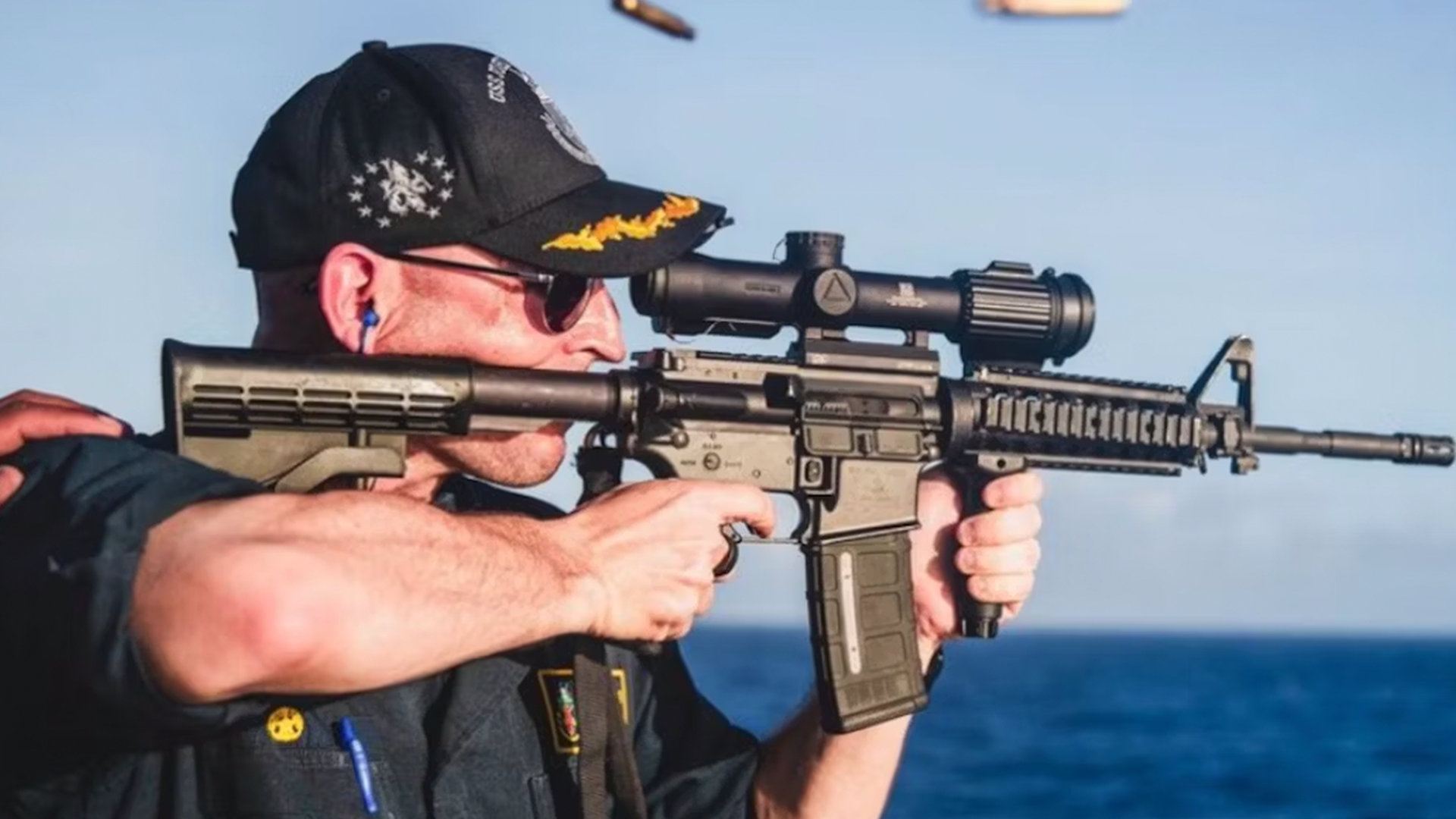America’s unserious political class is totally unequipped to deal with the threat.
Through a Scope Backwards

A recent publicity photo from the Navy tells us more than we wanted to know about military readiness.
The U.S. Navy recently released a photograph on social media showing a sailor firing his M-4 aboard a ship. No doubt some public relations officer thought the picture looked great—a fit and ready sailor shooting his rifle, with spent cartridges flying. A perfect picture for a recruitment catalog, except for one crucial detail: the rifle’s scope—which the sailor appears to be looking through—is mounted backwards, and its lens covers appear to be closed. A swift social media uproar arose over the bizarre and glaring error. Someone with actual military experience in the Navy evidently noticed what this photo said without words, because the picture was quickly deleted.
Too late, for this image of bastardized military training is already the allegory for the collapse of the military profession and America’s deployment of military force around the world. The glaring deficiencies in this photo go a long way towards understanding the U.S. military in 2024. Outkick has a hilariously tragic rundown of all that is wrong with the picture, but there is a lesson for those Americans concerned about the institutional integrity of a military on the precipice of war in different regions of the world.
Many veterans will recognize the notion and verbiage of a “box check exercise,” that being a colloquial phrase used to describe drills a military unit undergoes to fulfill a prescribed process. Box-check exercises are frequently unrelated to easier or more functional parts of a unit training calendar. From a veteran Army infantryman, one would think shooting rifles aboard a Navy destroyer epitomizes the notion of a “box-check exercise.”
The PR kit-ready photograph makes it seem as if the Navy does not take this kind of training seriously either. The rifleman in the photo displays unfamiliarity with firing a rifle. He barely braces the buttstock with his shoulder, a recipe for missing the target and winding up with a black eye.
His forward hand grip is useless for even modest marksmanship objectives. Gripping the rifle so close to the magazine creates a fulcrum effect that destabilizes any attempt at a target sight picture. His right hand on the pistol grip is positioned insufficiently to control the recoil if the point is to hit the target at which he aims.
The backward-mounted scope says everything there is to imagine about the effectiveness and purpose of military training and command. It does not require military experience to wonder what the rifleman would have been seeing through the sight.
Commentators have discussed two other observations less, but they are instrumental in this cultural allegory. The quad rail around the barrel appears poorly configured as if the rails are wedged “good enough” in between the receiver and the front sight post. When military training is a box check, “good enough” seems to suffice for the USS John S. McCain.
The rifleman is also shooting this weapon on the “fully automatic” setting. In six years of active-duty service as an Army Ranger in training and combat, this author never observed an occasion for an American to shoot a rifle on “full auto.” For this sailor, however, why not have some absurd fun?
A final detail is the most disturbing of all. An insignia on the rifleman’s uniform reveals him to the commander of the ship on which this “training” took place. That officer, CDR Cameron Yates, has served for almost twenty years, so presumably he would have recognized the direction of the scope, his poor hand placement, or the hail of bullets aimlessly leaving his barrel. Or maybe he wanted to blaze away recklessly on “full auto” to make a good Instagram post.
But why is there a hand on his shoulder?
Much ink and airtime are spent pondering the right balance of military resources and personnel across the globe. Hidden in debates about end strength, shipbuilding, and cruise missiles is the troubling reality the military does not take itself seriously enough to fight any of the potential wars that could unfold in the coming weeks.
The Navy chose to brag about the fact that a Commanding Officer of a destroyer is leading his ship by shooting his poorly configured rifle on full automatic, looking through a backward and closed scope, in a manner that would produce no effect on an intended target.
The Navy will surely claim that this was a one-off mistake by some low-level publicity flunky, and we should not let it distract from the very serious work of sailors around the world. Instead, let us use this photograph as a spur to examine what else about the military is discarded, off target, and carelessly trained before it is too late.
The American Mind presents a range of perspectives. Views are writers’ own and do not necessarily represent those of The Claremont Institute.
The American Mind is a publication of the Claremont Institute, a non-profit 501(c)(3) organization, dedicated to restoring the principles of the American Founding to their rightful, preeminent authority in our national life. Interested in supporting our work? Gifts to the Claremont Institute are tax-deductible.
The U.S. military has deteriorated to the point where it might not be able to win even one major battle, much less two simultaneously.
An underappreciated film showcases post-war masculine anxieties.



